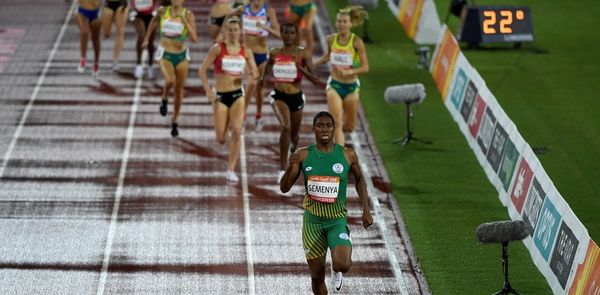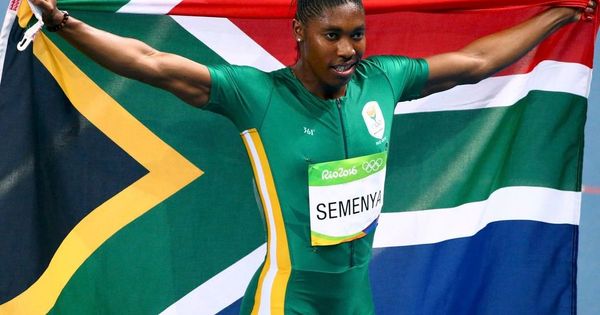
In the intricate and emotional case of Caster Semenya, there is no such thing as fair. Her situation vexes traditional sports logic. It challenges the inflexibility of the way we divided athletics long ago: Males are easily defined as males and should compete against other males; and females are easily defined as females and should compete against other females.
It was all neat and tidy until further study taught us not to assume the biological purity of two genders. The body is too complex, and the concept of sex is far more complicated than imagined. In high-level sports, we appreciate and expect the best athletes to have biological advantages that contribute to gifts such as strength, endurance, speed, leaping and agility. For as much as we amplify their great training and hard work, we also marvel at their extraordinary physical makeup, provided that they are a natural creation and not the product of doping. In that sense, the notion of a fair and level playing field is quite vast because we accept that sometimes evolutionary superstars are needed to whip the field, wow the audience and provide a preview of what’s to come.
It’s wonderful, celebrated even, to have LeBron James, Michael Phelps, Usain Bolt, Serena Williams, Katie Ledecky and Simone Biles among us. They can be placed cleanly into our man-woman sports categorization. But Caster Semenya? As the dominant two-time Olympic champion in the women’s 800 meters and a three-time world champion, she’s just as special as they are. But she is considered different because it is believed she has an intersex condition that makes her body naturally produce a high level of testosterone.
In the myopic manner that we view gender and sports, Semenya is a biological oddity. And so the solution — delivered as a measure of fairness to “normal” females racing against Semenya — is quite cruel: change or go away. To compete in the biggest international track events, Semenya has to take medications to decrease her testosterone level. If she declines, there is no place for her on the grandest stage.
On Wednesday, the Court of Arbitration for Sport ruled against Semenya’s appeal in the landmark case and chose to uphold the International Association of Athletics Federations’ rule. It took the panel of three judges more than two months to decide, by a 2-1 margin, that the IAAF is right to have a policy targeting the testosterone levels of women competing at distances ranging from 400 meters to a mile.
Semenya and other athletes with difference of sexual development (DSD) must lower their testosterone levels below 5 nanomoles per liter of blood and keep them there for at least six months before they’re allowed to compete. It’s ironic that, in a sport troubled by athletes doping to elevate performance, the answer to this complicated issue is to force a dope down, in essence.
After the ruling, Semenya posted a Twitter message that featured a shrugging emoji and a short sentence in capital letters: “Sometimes it’s better to react with no reaction.”
Ultimately, this was a decision to protect 99.9 percent of competitors at the expense of the other 0.1 percent. Neither the IAAF nor CAS arrived at it easily. But they thought it was essential, in this situation, to prefer parity to promote the sport’s growth and maintain the integrity of competition. They disliked the alternative, which would have been to let Semenya, a 28-year-old South African, keep dominating, remain mired in controversy and risk a portion of the competition straying from the 800-meter event. They chose to side with the bigger crowd because there was no better way out.
It feels wrong. But honestly, I’m not sure we have the mental agility to arrive at right. It’s possible to be cruel without having cruel intentions. It’s possible to be unfair while in pursuit of fairness. And it’s inevitable that, in trying to get through this labyrinth, there will be some flawed approaches.
Here’s one problem. In announcing the rule about a year ago, IAAF President Sebastian Coe included these thoughts in a statement: “The revised rules are not about cheating, no athlete with a DSD has cheated, they are about leveling the playing field to ensure fair and meaningful competition in the sport of athletics where success is determined by talent, dedication and hard work rather than other contributing factors.”
The complication in Coe’s desire for an environment where “success is determined by talent, dedication and hard work rather than other contributing factors” is determining what’s a “talent” and what’s an outside “contributing factor.”
We all accept that our bodies possess differences in athletic abilities. And we always have accepted a necessary division of men and women. But we never accounted for biological overlap, and now that gender is more fluid than we realize, the IAAF just wants to force normalcy, even if that never really existed.
To prepare to write this column, I read and spoke to bioethicists on the issue. I consulted other great thinkers. I sought wisdom that would lead to a clear and unassailable point of view. But I kept coming back to the words of Thomas Murray. He’s a leading sports ethicist and the author of “Good Sport: Why Our Games Matter — And How Doping Undermines Them.”
He offered incredible insight but also a warning: “You’re balancing considerations that just don’t afford an easy solution.”
Great, I told him.
“It’s what philosophers call a hard problem,” he said.
A hard problem of consciousness? Yeah, I would be better off doing another round of Jordan vs. LeBron.
The CAS began its ruling by nodding to the difficulty: “After setting out the parties’ evidence and submissions, the Panel begins its analysis of the merits by noting that this case involves a complex collision of scientific, ethical and legal conundrums. It also involves incompatible, competing rights. It is not possible to give effect to one set of rights without restricting the other set of rights.”
There is no right answer in Semenya’s case, just the inevitability that someone was going to feel wronged. There is an evolving understanding of science, and it feels as if we’re just at the beginning of an era of transforming gender identity. Greater research will be conducted, and stronger arguments will be made. In the process, perhaps the traditional definition of man and woman will undergo radical change. Perhaps our categorizations are too narrow. It is a separate issue, but in the near future, there will need to be a more nuanced transgender discussion as well.
For now, we just know this: Semenya lost an appeal during a time in which the sports world is just coming to terms with the DSD dilemma. It could have long-reaching ramifications throughout all levels of sports. But let’s hope, in time and with greater knowledge, we can revisit this policy and our current instincts about DSD.
While you should respect the deep thinking in figuring out a stance to take, there was something wholly incomplete and unsatisfying about Wednesday’s decision. Semenya and her legal team had challenged the IAAF rules were discriminatory. The CAS agreed, but then it escaped through a back door by declaring, according to a release, “the majority of the Panel found that, on the basis of the evidence submitted by the parties, such discrimination is a necessary, reasonable and proportionate means of achieving the IAAF’s aim of preserving the integrity of female athletics.”
So that’s how it ends, for now, with necessary discrimination. That also can be taken as “the way we operate is too rigid to accept you.”
Even though sports have to work that way sometimes, the world doesn’t. Sadly, Semenya may have to turn into a martyr, but this isn’t over. Our gender definitions are fraying. There is more to come because there is more to learn.










